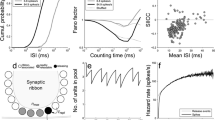Summary
The response properties of cat horizontal canal afferents (N = 81) were characterized by three parameters: their long time constants (τ), low frequency gain constants (G1), and middle frequency gain constants (Gm). An average value of each of these parameters was calculated for each of eight animals and comparisons were made across animals. There were significant differences between individual animals in their average values of τ and Gm. There was also a significant negative correlation between τ's and Gm's. An animal with a larger average τ tended to have a smaller average Gm. We also used anatomic data on membranous canal duct diameter from the literature to independently estimate the potential effect of interanimal anatomic variability on the predicted range of τ and Gm values in a population. We then compared the data from our 81 afferents with the predictions from the anatomic data.
Similar content being viewed by others
References
Blanks RHI, Estes MS, Markham CH (1975) Physiologic characteristics of vestibular first-order canal neurons in the cat. II. Response to constant angular acceleration. J Neurophysiol 38: 1250–1268
Carpenter RHS (1977) Movements of the eyes. Pion, London
Curthoys IS, Blanks RHI, Markham CH (1977a) Semicircular canal radii of curvature (R) in cat, guinea pig, and man. J Morph 151: 1–16
Curthoys IS, Markham CH, Curthoys EJ (1977b) Semicircular duct and ampulla dimensions in cat, guinea pig and man. J Morph 151: 17–34
Egmond AAJ van, Groen JJ, Jongkees LBW (1949) The mechanics of the semicircular canal. J Physiol (Lond) 110: 1–17
Ezure K, Cohen MS, Wilson VJ (1983) Response of cat semicircular canal afferents to sinusoidal polarizing currents: implications for input-output properties of second-order neurons. J Neurophysiol 49: 639–648
Fernandez C, Goldberg JM (1971) Physiology of peripheral neurons innervating semicircular canals of the squirrel monkey. II. Response to sinusoidal stimulation and dynamics of peripheral vestibular system. J Neurophysiol 34: 661–675
Fernandez C, Valentinuzzi M (1968) A study on the biophysical characteristics of the cat labyrinth. Acta Otolaryng 65: 293–310
Goldberg JM, Fernandez C (1971) Physiology of peripheral neurons innervating semicircular canals of the squirrel monkey. I. Resting discharge and response to constant angular accelerations. J Neurophysiol 34: 635–660
Goldberg JM, Fernandez C, Smith CE (1982) Responses of vestibular-nerve afferents in the squirrel monkey to externally applied galvanic currents. Brain Res 252: 156–160
Hollander M, Wolfe DA (1973) Nonparametric statistical methods. Wiley and Sons, New York
Howland HC, Masci J (1973) The functional allometry of semicircular canals, fins, and body dimensions in the juvenile centrarchid fish, Leopomis gibbosus (L.). J Embryol Exp Morph 29: 721–743
Melvill Jones G, Milsum JH (1970) Characteristics of neural transmission from the semicircular canal to the vestibular nuclei of cats. J Physiol (Lond) 209: 295–316
Melvill Jones G, Spells KE (1963) A theoretical and comparative study of the functional dependence of the semicircular canal upon its physical dimensions. Proc R Soc Lond 157B: 403–419
Oman CM (1981) The influence of duct and utricular morphology on semicircular canal response. In: Gualtierotti T (ed) The Vestibular System: Function and Morphology. Springer, Berlin Heidelberg New York, pp 251–272
Schneider LW, Anderson DJ (1976) Transfer characteristics of first and second order lateral canal vestibular neurons in gerbil. Brain Res 112: 61–76
Seidel RC (1975) Transfer-Function Parameter Estimation From Frequency Response Data — a Fortran Program. NASA Technical Memorandum, NASA TM X-3286, Washington, D.C.
Segal BN, Outerbridge JS (1982) Vestibular (semicircular canal) primary neurons in bullfrog: nonlinearity of individual and population response to rotation. J Neurophysiol 47: 545–562
Segal BN, Outerbridge JS (1982) A nonlinear model of semicircular canal primary afferents in bullfrog. J Neurophysiol 47: 563–578
Steinhausen W (1933) Über die Beobachtung der Cupula in den Bogengangsampullen des Labyrinthes des lebenden Hechts. Pflüger's Arch Ges Physiol 232: 500–512
Taglietti V, Rossi ML, Casella C (1977) Adaptive distortions in the generator potential of semicircular canal sensory afferents. Brain Res 132: 41–57
Tomko DL, Peterka RJ, Schor RH, O'Leary DP (1981) Response dynamics of horizontal canal afferents in barbiturate anesthetized cats. J Neurophysiol 45: 376–396
Valli P, Zucca G (1976) The origin of slow potentials in semicircular canals of the frog. Acta Otolaryngol 81: 395–405
Wilson VJ, Melvill Jones G (1979) Mammalian Vestibular Physiology. Plenum, New York
Author information
Authors and Affiliations
Rights and permissions
About this article
Cite this article
Peterka, R.J., Tomko, D.L. Differences between cats in response properties of horizontal semicircular canal primary afferents. Exp Brain Res 56, 162–166 (1984). https://doi.org/10.1007/BF00237453
Received:
Accepted:
Issue Date:
DOI: https://doi.org/10.1007/BF00237453




